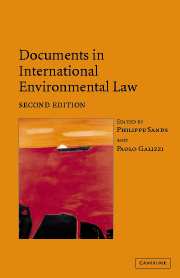Book contents
- Frontmatter
- Contents
- Preface
- PART I General instruments
- PART II Atmosphere
- PART III Oceans: global
- PART IIIB Oceans: regional
- PART IV Freshwater resources
- PART V Biodiversity
- PART VIA Hazardous substances and activities: nuclear
- PART VIB Hazardous substances and activities: pesticides
- PART VIC Hazardous substances and activities: waste
- 28 Convention on the Control of Transboundary Movements of Hazardous Wastes and Their Disposal, 22 March 1989
- 28A Decision III/1 of the Conference of the Parties (Amendment to the Basel Convention), 22 September 1995 (the ‘Basel Ban’)
- 28B Protocol on Liability and Compensation for Damage Resulting from Transboundary Movements of Hazardous Wastes and Their Disposal, 10 December 1999
- 29 Convention on the Ban of the Import into Africa and the Control of Transboundary Movement and Management of Hazardous Wastes within Africa, 29 January 1991
- 30 Code of Practice on the International Transboundary Movement of Radioactive Waste, 21 September 1990
- PART VII Human rights and the environment
- PART VIII War and the environment
- PART IX Trade and the environment
- PART X Environmental impact assessment and access to information
- PART XI Liability for environmental damage and breaches of environmental obligations
- PART XII The Antarctic
29 - Convention on the Ban of the Import into Africa and the Control of Transboundary Movement and Management of Hazardous Wastes within Africa, 29 January 1991
Published online by Cambridge University Press: 05 June 2012
- Frontmatter
- Contents
- Preface
- PART I General instruments
- PART II Atmosphere
- PART III Oceans: global
- PART IIIB Oceans: regional
- PART IV Freshwater resources
- PART V Biodiversity
- PART VIA Hazardous substances and activities: nuclear
- PART VIB Hazardous substances and activities: pesticides
- PART VIC Hazardous substances and activities: waste
- 28 Convention on the Control of Transboundary Movements of Hazardous Wastes and Their Disposal, 22 March 1989
- 28A Decision III/1 of the Conference of the Parties (Amendment to the Basel Convention), 22 September 1995 (the ‘Basel Ban’)
- 28B Protocol on Liability and Compensation for Damage Resulting from Transboundary Movements of Hazardous Wastes and Their Disposal, 10 December 1999
- 29 Convention on the Ban of the Import into Africa and the Control of Transboundary Movement and Management of Hazardous Wastes within Africa, 29 January 1991
- 30 Code of Practice on the International Transboundary Movement of Radioactive Waste, 21 September 1990
- PART VII Human rights and the environment
- PART VIII War and the environment
- PART IX Trade and the environment
- PART X Environmental impact assessment and access to information
- PART XI Liability for environmental damage and breaches of environmental obligations
- PART XII The Antarctic
Summary
Editorial note
The Bamako Convention on the Ban of the Import into Africa and the Control of Transboundary Movement and Management of Hazardous Wastes within Africa, adopted under the auspices of the OAU, is a regional agreement which prohibits the importation of hazardous wastes into Africa but permits its regulated movement within Africa. The ban on importation of hazardous wastes is absolute and any violation of it is considered a criminal act (Article 4(1)). The dumping of hazardous wastes at sea is also prohibited (Article 4(2)).Hazardous wastes is defined by the Convention by reference to category and characteristics outlined in the Annexes to the Convention (Article 2(1)). Wastes will also be hazardous if they are so defined by domestic legislation of a Party of export, import or transit, and will be deemed to be hazardous if they are banned or not registered with governmental authorities in the manufacturing country for human health or environmental reasons (Article 2(1)). The Convention applies to radioactive wastes (Article 2(2)), but not those discharged through the normal operation of ships which are regulated by other international instruments (Article 2(3)).
The ‘preventive, precautionary’ approach to pollution problems is to guide the Parties and they are required to co-operate to implement the ‘precautionary principle’ by applying clean production techniques (Article 4(3)(f)). Parties are further required to promote clean production methods that apply to a product's entire life cycle (Article 4(3)(g)).
- Type
- Chapter
- Information
- Documents in International Environmental Law , pp. 936 - 967Publisher: Cambridge University PressPrint publication year: 2004



